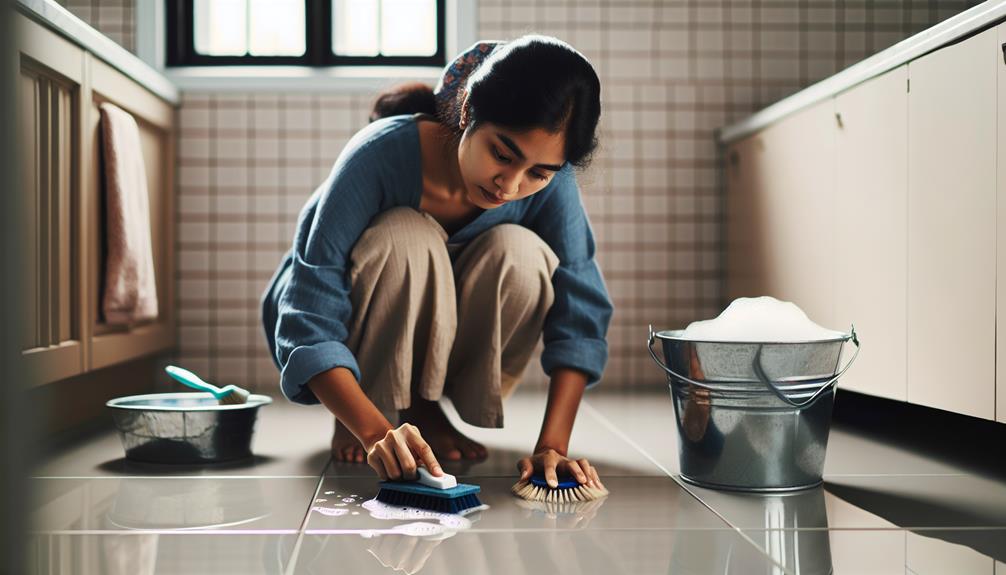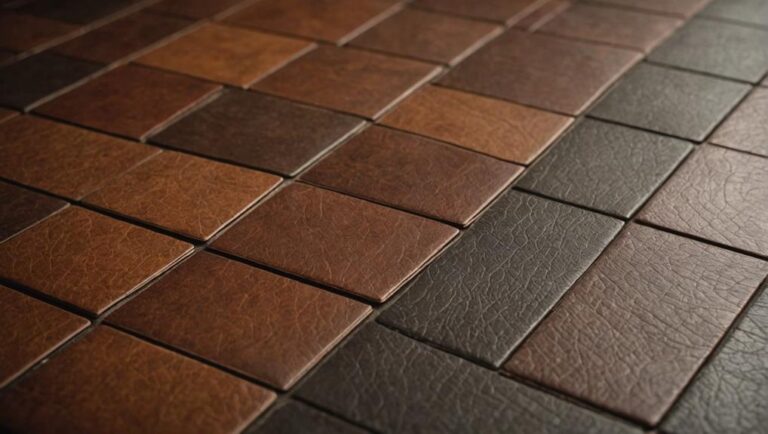To clean floor tile grout, grab a grout brush for scrubbing. Mix water and vinegar for a cleaning solution. Add baking soda for tough spots. Focus on small areas for thorough cleaning. Wipe with a microfiber cloth. For extra strength, try homemade mixes like baking soda and water. To elevate your cleaning game, learn more about professional services and maintenance tips. Your floors will thank you!
Importance of Clean Grout
To maintain a healthy and attractive living space, keeping your grout clean is essential. Dirty grout not only looks unsightly but can also harbor germs and bacteria. Imagine walking barefoot on a floor with grimy grout – not a pleasant thought, right? By ensuring your grout is clean, you create a more hygienic environment for yourself and your loved ones.
Moreover, clean grout helps prolong the life of your tiles. When grout is dirty, it can weaken the adhesive that holds the tiles in place, leading to potential damage and costly repairs down the line. By regularly cleaning your grout, you aren’t only preserving the aesthetic appeal of your space but also enhancing its durability.
In essence, maintaining clean grout is a small yet impactful way to elevate the overall look and feel of your home. It doesn’t take much effort, but the results are definitely worth it. So why not take a few minutes to give your grout some love and enjoy a cleaner, healthier living space?
Essential Tools and Materials
When addressing the task of cleaning floor tile grout, having the right tools and materials at your disposal is vital for achieving effective results. Here are three essential items you’ll need:
- Grout Brush: A sturdy grout brush with firm bristles is essential for scrubbing away dirt and grime from the grout lines. Look for one with an ergonomic handle to make the job easier on your hands.
- White Vinegar: This natural cleaning agent is excellent for cutting through tough grime and mold in grout lines. Mix it with water in a 1:1 ratio in a spray bottle for an effective DIY grout cleaner.
- Microfiber Cloths: These lint-free cloths are perfect for wiping down tiles after cleaning the grout. They’re highly absorbent and help guarantee a streak-free finish on your tiles.
Having these tools and materials on hand will make the cleaning process smoother and more efficient, giving you the freedom to enjoy sparkling clean grout lines in no time.
Pre-Cleaning Preparation
Make sure you have collected all the essential tools and materials before moving on to the pre-cleaning preparation for your floor tile grout. Here’s a quick guide to help you get ready:
| Tools | Materials |
|---|---|
| Scrub Brush | Baking Soda |
| Grout Brush | White Vinegar |
| Microfiber Cloth | Hydrogen Peroxide |
| Bucket | Water |
Before you start cleaning the grout, it’s important to sweep or vacuum the floor to remove any loose dirt and debris. This will prevent the dirt from getting trapped in the grout lines during the cleaning process. Next, mix a solution of equal parts water and vinegar in a bucket. For tougher stains, you can also add baking soda or hydrogen peroxide to the mixture. Use the scrub brush or grout brush to apply the solution to the grout lines and let it sit for a few minutes to loosen any dirt or grime. Finally, scrub the grout lines with the brush and then wipe clean with a damp microfiber cloth. This pre-cleaning preparation will make the actual grout cleaning process much more effective.
Homemade Grout Cleaner Recipes
Consider mixing baking soda and water to create a simple yet effective homemade grout cleaner. This natural solution can help you tackle stubborn grime and dirt on your floor tile grout.
Here are some other homemade grout cleaner recipes you can try:
- Vinegar and Water: A mixture of vinegar and water can be a powerful grout cleaner. The acidity of the vinegar helps break down dirt and grime, leaving your grout sparkling clean.
- Hydrogen Peroxide and Baking Soda: This combination creates a powerful foaming action that can penetrate deep into the grout lines, lifting out tough stains and bacteria.
- Lemon Juice and Baking Soda: The natural acidity of lemon juice combined with the abrasive texture of baking soda can work wonders on dirty grout. Plus, it leaves behind a fresh citrus scent.
These homemade grout cleaner recipes aren’t only effective but also safe for you and the environment. Give them a try and see the difference they can make in keeping your floor tile grout looking clean and fresh.
Scrubbing Techniques
To achieve high-quality cleanliness, employ thorough and efficient scrubbing techniques on your floor tile grout. Start by using a stiff-bristled brush or an old toothbrush to scrub the grout lines vigorously. Focus on small sections at a time to make certain that no spot is missed.
For stubborn stains, create a paste using baking soda and water, apply it to the grout lines, and scrub with a brush. Rinse the area with water and wipe it clean. Another effective method is to mix equal parts of vinegar and water in a spray bottle, spray it onto the grout, let it sit for a few minutes, then scrub with a brush.
Remember to rinse the area thoroughly after scrubbing to remove any residue. By incorporating these scrubbing techniques into your cleaning routine, you can keep your floor tile grout looking fresh and immaculate.
Steam Cleaning Method
For a quick and effective way to clean floor tile grout, consider utilizing the steam cleaning method. Steam cleaning offers a hassle-free approach to deep clean and sanitize your grout lines without harsh chemicals.
Here are three reasons why you should give steam cleaning a try:
- Effortless Operation: Steam cleaners are easy to use; simply fill the tank with water, wait for it to heat up, and then press the trigger to release hot steam onto the grout lines. The steam works to loosen dirt and grime, making it effortless to wipe away.
- Chemical-Free Cleaning: If you prefer cleaning without chemical-laden products, steam cleaning is an excellent option. The high-temperature steam effectively kills bacteria and germs, leaving your grout naturally clean and sanitized.
- Time-Saving Solution: With steam cleaning, you can cover larger areas in less time compared to traditional scrubbing methods. The steam penetrates deep into the grout, making it easier to remove stubborn stains and dirt, saving you time and effort.
Using a Grout Sealer
Using a grout sealer helps safeguard your floor tile grout from stains and moisture, extending its lifespan and maintaining a clean appearance. Sealing the grout creates a barrier that prevents liquids and dirt from infiltrating the porous surface, making it easier to clean spills and preserve the grout’s original color.
To apply the sealer, make sure the grout is clean and dry, then use a small brush or roller to evenly coat the grout lines. Wipe off any excess sealer from the tiles before it dries to avoid a hazy residue. It’s recommended to reapply the sealer annually or as needed, especially in high-traffic areas or areas prone to spills. A quality grout sealer won’t only protect your grout but also make routine cleaning a breeze.
Maintenance Tips for Clean Grout
Regular cleaning and gentle scrubbing are crucial for maintaining clean grout in between sealing sessions. To keep your grout looking fresh and tidy without the need for frequent deep cleaning, follow these maintenance tips:
- Wipe Down Regularly: After showering or cooking, promptly wipe down the grout lines with a damp cloth to prevent dirt and grime buildup.
- Use Mild Cleaners: Opt for mild cleaners like vinegar or baking soda to avoid damaging the grout while still effectively removing stains.
- Ventilate Well: Guarantee proper ventilation in the room to reduce moisture levels, which can contribute to mold and mildew growth in the grout.
Professional Cleaning Services
Consider hiring professional cleaning services to tackle tough grout stains and deep-seated dirt that regular maintenance may not fully address. Sometimes, despite your best efforts, grout can accumulate stubborn stains and dirt that seem impossible to remove with DIY methods. Professional cleaners have the expertise, specialized tools, and powerful cleaning solutions to effectively deep clean your grout lines, restoring them to their original pristine condition.
By outsourcing this task, you can save yourself time and energy, allowing you to focus on other priorities. Additionally, professional cleaning services can prolong the lifespan of your grout by preventing mold and mildew growth, which can compromise the integrity of the grout over time.
Frequently Asked Questions
If you’re curious about typical questions concerning cleaning floor tile grout, we’ve got you taken care of. Here are some frequently asked questions that might help you out:
- Can I use bleach to clean grout?
Bleach can be effective in whitening grout but should be used with caution as it can be harsh on the grout and surrounding tiles. Always test in a small inconspicuous area first.
- How often should I clean my floor tile grout?
Ideally, you should clean your floor tile grout at least once a month to prevent dirt and grime buildup. However, high-traffic areas may require more frequent cleaning.
- Is it necessary to seal grout after cleaning?
Yes, sealing grout after cleaning helps protect it from staining and water damage. It’s recommended to reseal grout every 1-2 years, depending on usage and the type of sealer used.
Frequently Asked Questions
Can I Use Bleach to Clean Grout?
Yes, you can use bleach to clean grout. It’s effective at removing stains and brightening grout lines. Dilute it with water, apply it to the grout, let it sit, scrub gently, then rinse thoroughly to reveal clean grout.
How Often Should I Clean My Grout?
You should clean your grout every 1-2 weeks to keep it looking fresh. Regular maintenance prevents dirt buildup and makes deep cleaning easier. Use a mild solution and scrub gently for best results.
What Is the Best Way to Prevent Mold and Mildew From Forming in Grout?
To prevent mold and mildew in grout, keep moisture levels low by using a squeegee after showering. Ventilate well, and fix leaks promptly. Maintain cleanliness with regular cleaning and treat with a mold-resistant sealant.
Can I Use a Steam Cleaner on Colored Grout?
Yes, you can use a steam cleaner on colored grout. It provides a deep clean without damaging the color. Remember to test a small, inconspicuous area first to guarantee the steam doesn’t impact the color.
Is It Necessary to Reseal Grout After Cleaning?
After cleaning grout, it’s wise to reseal it for added protection. This step helps maintain the cleanliness and durability of your grout. Make it a habit to reseal periodically to keep your floors looking fresh.




